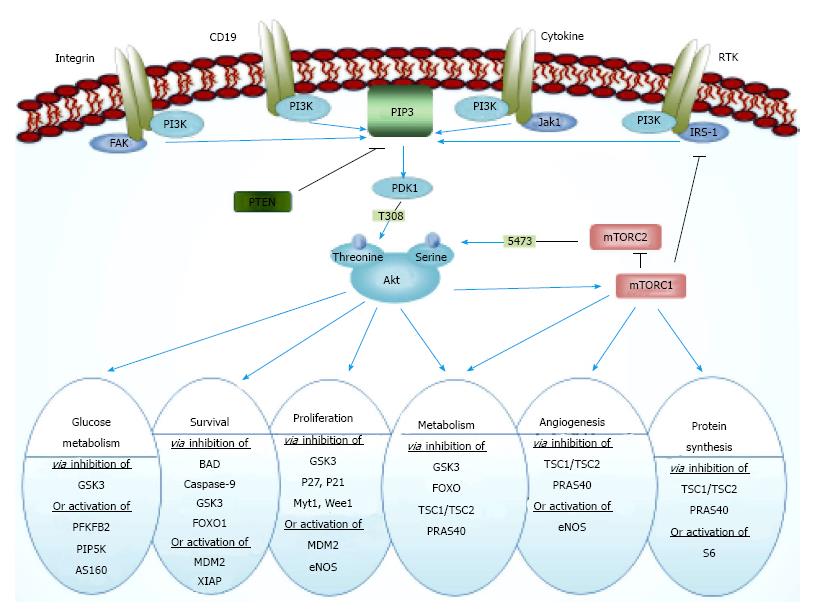Copyright
©The Author(s) 2016.
World J Clin Oncol. Oct 10, 2016; 7(5): 352-369
Published online Oct 10, 2016. doi: 10.5306/wjco.v7.i5.352
Published online Oct 10, 2016. doi: 10.5306/wjco.v7.i5.352
Figure 1 Phosphatidylinositol 3 kinase/Akt pathway.
Activated RTKs activate PI3K through direct binding or through tyrosine phosphorylation of scaffolding adaptors, such as IRS1, which then bind and activate PI3K. PI3K phosphorylates PIP2 to generate PIP3, in a reaction that can be reversed by the PIP3 phosphatase PTEN. Activation of PI3K results in membrane recruitment and thus activation of Akt protein. Akt regulates cell growth and many other cellular processes through its effects on mTOR pathways and thus regulates glucose metabolism, protein synthesis, mitochondrial metabolism, lipid metabolism, adipogenesis, lipogenesis, angiogenesis, autophagy, proliferation and cell growth. Other targets of Akt include insulin receptor substrate-1 (IRS-1), glycogen synthase kinase 3 (GSK3), phosphodiesterase-3B (PDE-3), B cell lymphoma-2-associated death promoter (BAD), human caspase-9, Forkhead box (FOX) and nuclear factor kappa-light-chain-enhancer of activated B cells (NFκB) transcription factors, endothelial nitric oxide synthase (eNOS), Rapidly Accelerated Fibrosarcoma (Raf) kinases, P21CIP1/WAF1 (P21; a potent cyclin-dependent kinase inhibitor), P27Kip1, Tuberous Sclerosis Complex 2 (TSC2; also known as Tuberin), X-linked inhibitor of apoptosis protein (XIAP; also known as inhibitor of apoptosis protein 3 and baculoviral IAP repeat-containing protein 4), and Mouse Double Minute 2. Following the activation, Akt phosphorylates and blocks the molecules involved in the apoptotic pathway, including FOX, Caspase-9 and BAD. In addition to the inhibition of proapoptotic factors, Akt can activate the transcription of antiapoptotic genes through the activation of the transcription factor Rel/NFκB. Akt also phosphorylates and activates IκB, which results in IκB degradation by the proteasome. This allows NFκB to translocate from the cytoplasm to the nucleus and activate transcription of a variety of substrates including anti-apoptotic IAP genes, such as the c-IAP1 and c-IAP2. IRS1: Insulin receptor substrate 1; PI3K: Phosphatidylinositol 3-kinase; PIP3: Phosphatidylinositol-3,4,5-trisphosphate; PTEN: Phosphate and tensin homologue; RTK: Receptor tyrosine kinase.
- Citation: Avan A, Narayan R, Giovannetti E, Peters GJ. Role of Akt signaling in resistance to DNA-targeted therapy. World J Clin Oncol 2016; 7(5): 352-369
- URL: https://www.wjgnet.com/2218-4333/full/v7/i5/352.htm
- DOI: https://dx.doi.org/10.5306/wjco.v7.i5.352









